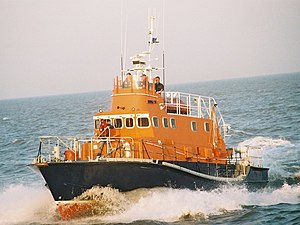Canadian Coast Guard Arun-class lifeboats
 |
|
| Class overview | |
|---|---|
| Builders: |
|
| Operators: |
|
| Preceded by: | Waveney |
| Succeeded by: | Severn |
| Cost: | £128,000 (52-01) – £640,000 (52-46) |
| Built: | 1971–1990 |
| In service: | 1971–2008 |
| Completed: | 46 |
| Retired: | 46 |
| Preserved: | 1 |
| General characteristics | |
| Displacement: | 32 long tons (33 t) |
| Length: | 52 ft (16 m) or 54 ft (16 m) |
| Beam: | 17 ft (5.2 m) |
| Draught: | 5 ft (1.5 m) |
| Propulsion: |
|
| Speed: | 18.5 knots (21.3 mph) |
| Range: | 250 nautical miles (460 km) |
| Complement: | 6 |
The Arun-class lifeboat was a fast all-weather lifeboat designed by the Royal National Lifeboat Institution (RNLI) for service at its stations around the coasts of the United Kingdom and Ireland. They were operated by the RNLI between 1971 and 2008. Many have been sold to see further service in the lifeboat and coastguard services of other countries.
The class takes its name from the River Arun in Sussex, England.
The RNLI's first lifeboat capable of speeds in excess of 10 knots (12 mph) was the 14 knots (16 mph) Waveney-class introduced in 1967. This was based on an American design, but in 1971 it was supplemented by the Arun-class which was designed by the RNLI and gave vastly improved accommodation and increased the speed to 18.5 knots (21.3 mph).
The first prototype boat entered service at St Peter Port in 1972 but moved on to Barry Dock where it was stationed until 1997. Two more boats were introduced in 1973 and 1974 and then full production started in 1975 although small numbers of Waveney-class boats were still built until 1982. By 1990, 46 Arun-class boats had been launched. The following year saw the launch of the first 25 knots (29 mph) Severn- and Trent-class boats.
The three prototype boats were withdrawn between 1994 and 1997, the third of which then went on display at the National Lifeboat Museum. The production series boats were taken out of regular service between 1998 and 2007. While a few have found new uses around the coast of Great Britain, the majority have been sold to other lifeboat operators around the world, predominantly in China, Finland and Iceland and some further boats were built new for service in Canada and Greece. Those travelling long distances go as deck cargo on larger ships but those going to closer harbours are generally sailed across under their own power. The first boat to go to Iceland, the Richard Evans, was loaded as deck cargo on a container ship but was washed overboard during the passage – the only Arun to have been lost at sea.
...
Wikipedia
